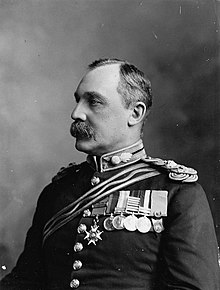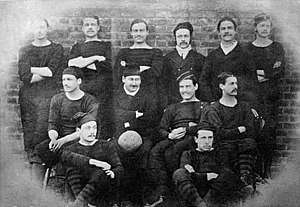George Hamilton Sim
Colonel George Hamilton Sim CB CMG (19 November 1852 – 27 December 1929[1]) was a British Army officer who served with the Royal Engineers in various campaigns in the 19th and early 20th centuries. In his youth, he was a keen amateur sportsman and played association football for the Royal Engineers, being on the winning side in the 1875 FA Cup Final.
George Hamilton Sim | |
|---|---|
 George Hamilton Sim in about 1918 | |
| Born | 19 November 1852 Paddington, London, England |
| Died | 27 December 1929 (aged 77) Pontefract, Yorkshire, England |
| Buried | Ocklynge Cemetery, Eastbourne, England |
| Allegiance | United Kingdom |
| Service/ | British Army |
| Years of service | 1872–1918 |
| Rank | Colonel |
| Unit | Royal Engineers |
| Awards | C.B., C.M.G. |
Family and education
Sim was born on 19 November 1852 at Paddington, London, the second son of Alexander Sim (1820–1885),[2] a timber broker.[3] Sim's mother, Agnes (1827–1909) was the daughter of Archibald Billing, a doctor and author.[4] He was baptised on 23 March 1853 at St James's Church, Paddington.[4]
Two of Sim's uncles, Edward Coysgarne Sim (1838–1900) and Charles Alexander Sim (1839–1897) served with the Royal Engineers, both reaching the rank of major-general.[5]
Sim was educated at Rugby School[1][6] before attending the Royal Military Academy, Woolwich.[1]
Football career
Sim played Association football at Rugby School and at the Royal Military Academy before joining the Royal Engineers in 1872. Described as ""a very useful back", Sim played as a full back; he was a pioneer in the art of heading the ball.[1]
When Sim joined the Royal Engineers, they were among the top football teams in England, having reached the final of the first FA Cup tournament in 1872 and again two years later, finishing on both occasions as runners-up.[7]
The Engineers reached the FA Cup Final for the third time in four years in 1875 but only after a hard semi-final against Oxford University, with a 1–1 draw followed by a 1–0 victory in the replay.[7] In the final, played on 13 March 1875 at Kennington Oval, the Engineers met the Old Etonians. The match was played in a strong gale and the Engineers spent most of the match against the gale, with the rules requiring ends to be changed after each goal. Alexander Bonsor scored for the Old Boys after 30 minutes followed by an equaliser from Capt Renny-Tailyour within five minutes. Shortly after the equaliser, Richard Ruck collided with Cuthbert Ottaway who was forced to leave the field with a serious ankle injury; in his absence, the Old Boys were regarded as fortunate to have held on for a 1–1 draw.[8][9]

The replay was three days later; although the Engineers were able to field the same eleven as in the first match, the Etonians had to make four changes, losing the match 2–0, with both the Engineers' goals scored by Capt Renny-Tailyour.[10] At the third attempt, the Royal Engineers won their first, and only, FA Cup Final.[11]
Military career
Sim graduated from RMA Woolwich on 12 September 1872, when he was commissioned as a lieutenant.[12] He spent the first three years in the army based at Chatham, Kent, before joining the Indian Service in August 1875.[2]
On 23 September 1875, Sim was sent to northern India, where he was to remain for the next nine years. In October 1879, he was appointed Assistant Field Engineer in the Northern Afghanistan Field Force, to participate in the second phase of the Afghan War for which he received the Afghanistan Medal.[2]
Sim returned to England in August 1884, to become an instructor at the Royal School of Military Engineering in Chatham,[2] being promoted to captain on 12 September 1884.[13] In March 1885, Sim was sent to Sudan with the second Suakin Expedition.[2] In Suakin, Sim was a member of the 10th Railway Company, Royal Engineers under the command of Major William Rathbone, and were responsible for the construction of an 18-inch gauge railway system around the town.[14] For his services in Sudan, he was awarded the Egypt Medal with clasp, together with the Khedive's Star.[2][15]
Following his return to England, Sim was assigned to the Ordnance Survey based at Derby in April 1886, where he served for the following five years. He returned to the School of Military Engineering in April 1891, becoming an instructor in tactics,[2] and being promoted to major on 16 March 1892.[16] Sim remained at Chatham until June 1898, when he rejoined the Ordnance Survey, and was posted to Dublin.[2]
On 4 October 1899, Sim was promoted to lieutenant-colonel,[17] following which he was sent to South Africa in November as Commander Royal Engineers with the 5th Division,[2] part of the Natal Field Force.[18] Immediately on his arrival in South Africa, he led the Royal Engineers at the Relief of Ladysmith, including the operations of 17 to 24 January 1900, and the action at Spion Kop. This was followed by the operations on 5 to 7 February at Vaal Krantz and the Battle of the Tugela Heights from 14 to 27 February and the subsequent action at Pieters Hill, before the British finally defeated the Boers and entered Ladysmith on 1 March.[2] Sim's actions during this phase of the Second Boer War earned him a brief mention in despatches from Lieutenant-General Sir Charles Warren.[19]
During the remainder of 1900, Sim commanded the Royal Engineers in various operations in Transvaal and Natal, including the action at Laing's Nek on 6 to 9 June, before moving into the Orange River Colony at the end of the year, where he remained for the duration of the war.[2] For his services in South Africa, Sim was mentioned in despatches three times by Lord Roberts,[20][21] following which, on 19 April 1901, he was appointed a Companion of the Most Honourable Order of the Bath (C.B.).[22] He also received the Queen's South Africa Medal with six clasps, and the King's South Africa Medal with two clasps,[2]
In May 1902, Sim returned to Ireland to resume his service with the Ordnance Survey[23] until October 1904,[2] when he was placed on half-pay,[24] having been promoted to Brevet colonel on 1 October 1903.[25] On 19 June 1905, he was appointed Colonel in charge of Royal Engineer Records, and placed in command of the Royal Engineer Depot at Chatham, with the substantive rank of Colonel in the Army.[26] He vacated his appointment as Officer in charge of Royal Engineer Records and was placed on half pay on 19 June 1909,[27] before retiring on 19 November 1909.[28]
First World War service
Following the outbreak of the First World War, Sim was appointed as an Officer in charge of Army Records.[29] On 30 June 1915, he was attached to Headquarters as Chief Engineer for the duration of the war.[30]
In the 1917 New Year Honours, he was appointed a Companion of the Most Distinguished Order of Saint Michael and Saint George (CMG), "in recognition of [his] valuable services in connection with the war".[31]
Marriage and children
On 5 August 1875 at St. Paul's Church, Wokingham, Sim married Bessie Katherine Hayward (1854–1927).[32] The couple had five children:[2]
- Evelyn Mabel Hayward, born 30 June 1876.
- Violet Bessie Hayward, born 20 July 1878,[33] died 3 April 1880.[34]
- Agnes Gwynneth Amy, born 19 April 1882.
- George Edward Herman, born 15 August 1886.
- Noel Eric Hayward, born 14 December 1890.
Both the sons served in the Army: George served with the Royal Engineers, reaching the rank of brigadier,[35][36] while Noel became a lieutenant-colonel in the York and Lancaster Regiment.[37]
Death
At Christmas 1929, Sim was visiting his younger son, Noel, at his home in Pontefract, Yorkshire. On 27 December, he was found dead on the floor of his bedroom, having collapsed with heart failure.[38][39] His funeral was held at St Anne's Church, Eastbourne, East Sussex on 2 January 1930.[37] His body was interred at Ocklynge Cemetery.[40]
In 2015, Sim's 1897 Royal Engineers Sword came up for auction at Mullock's Auctioneers in Shropshire, but was not sold.[41]
References
- Warsop 2004, p. 124.
- "British Regimental Registers of Service, 1756-1900". Ancestry.co.uk. Retrieved 16 July 2020.
- "National Probate Calendar (Index of Wills and Administrations) for Alexander Sim". Ancestry.co.uk. Retrieved 16 July 2020.
- "Church of England Births and Baptisms, 1813-1917". Ancestry.co.uk. Retrieved 16 July 2020.
- De Santis, Edward (2001). "Biographical Notes on Officers of the Royal Engineers". reubique.com. Retrieved 19 July 2020.
- "War honours". The Meteor. Rugby School (604): 11. 7 February 1917. Retrieved 16 July 2020.
- Collett 2003, pp. 527–528.
- "FA Cup Final: 1875". www.fa-cupfinals.co.uk. Retrieved 10 June 2020.
- Warsop 2004, p. 43.
- Warsop 2004, pp. 32–33.
- Gibbons 2001, pp. 44–45.
- "No. 23957". The London Gazette. 11 March 1873. p. 1455.
"No. 24249". The London Gazette. 28 September 1875. p. 4645. - "No. 25394". The London Gazette. 9 September 1884. p. 4039.
- De Santis, Edward (2001). "Company Sergeant Major Walter Frederick Donmall". www.reubique.com/. Retrieved 19 July 2020.
- Warsop 2004, p. 125.
- "No. 26281". The London Gazette. 22 April 1892. p. 2360.
- "No. 27130". The London Gazette. 27 October 1899. p. 6463.
- Preziosi, Andrew (2010). "Order of Battle: Army of Natal" (PDF). www.legionwargames.com. p. 6. Retrieved 19 July 2020.
- "No. 27183". The London Gazette. 17 April 1900. p. 2501. "While Colonel Sim was, with this party [17th Company, Royal Engineers], ascending the hill, he met Colonel Thorneycroft descending [from Spion Kop], having evacuated the position."
- "No. 27282". The London Gazette. 8 February 1901. p. 943.
- "No. 27282". The London Gazette. 8 February 1901. p. 978. "Lieut.-Colonel G. H. Sim, R.E. has been indefatigable in his work, and proved himself a most valuable Commanding Royal Engineer".
- "No. 27306". The London Gazette. 19 April 1901. p. 2697.
"No. 11296". The Edinburgh Gazette. 23 April 1901. p. 463. - Andrews, J.H. (April 1991). "A record copy of the one-inch Irish hill map" (PDF). The Charles Close Society. p. 5. Retrieved 19 July 2020.
- "No. 27719". The London Gazette (Supplement). 4 October 1904. p. 6365.
- "No. 27603". The London Gazette. 6 October 1903. p. 6091.
- "No. 27822". The London Gazette. 28 July 1905. p. 5223.
- "No. 28270". The London Gazette. 13 July 1909. p. 5384.
- "No. 28310". The London Gazette. 19 November 1909. p. 8555.
- "No. 28881". The London Gazette. 28 August 1914. p. 6795.
- "No. 29221". The London Gazette (Supplement). 6 July 1915. p. 6669.
- "No. 29916". The London Gazette (Supplement). 23 January 1917. p. 924.
"No. 13044". The Edinburgh Gazette. 26 January 1917. p. 227. - "Marriages". Bicester Herald. 27 August 1875. p. 8. Retrieved 21 July 2020.
- "Births". Northern Whig. 27 July 1878. p. 4. Retrieved 21 July 2020.
- "Deaths". Folkestone Express. 17 April 1880. p. 5. Retrieved 21 July 2020.
- "No. 29724". The London Gazette (Supplement). 25 August 1916. p. 8455.
- "No. 35246". The London Gazette (Supplement). 12 August 1941. p. 4707.
- "Colonel G.H Sim". The Times. 31 December 1929. p. 14. Retrieved 21 July 2020.
- "Colonel found dead". Londonderry Sentinel. 31 December 1929. p. 1. Retrieved 21 July 2020.
- "Christmas visit tragedy: Colonel found dead at Pontefract". Sheffield Independent. 30 December 1929. p. 5. Retrieved 21 July 2020.
- "Death of Colonel Hamilton Sim". Eastbourne Gazette. 1 January 1930. p. 18. Retrieved 21 July 2020.
- "Extremely rare 1897 Royal Engineers Sword issued to Lieutenant G H Sim". Mullocks Auctions Limited. 15 April 2015. Retrieved 21 July 2020.
Bibliography
- Collett, Mike (2003). The Complete Record of the FA Cup. Sports Books. ISBN 1-899807-19-5.
- Gibbons, Philip (2001). Association Football in Victorian England – A History of the Game from 1863 to 1900. Upfront Publishing. ISBN 1-84426-035-6.
- Warsop, Keith (30 November 2004). The Early F.A. Cup Finals and the Southern Amateurs. Nottingham: SoccerData. ISBN 978-1899468782.